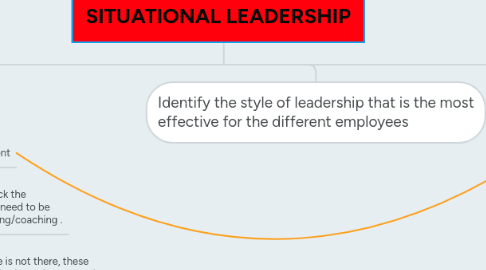
1. Styles of Leadership
1.1. S1: Directing/Telling
1.1.1. Give lots of direction such as problem solving. making decision and providing specific instructions.
1.1.1.1. Ensure that there is provision for what, why and how each tasks needs to be completed.
1.2. S2: Coaching/ Selling
1.2.1. Respond to employees by continuing to solve problems and make decisions, and closely supervise the task accomplishment.
1.2.1.1. Also, explain decisions, solicit suggestion and support employees learning progress; giving both direction and support.
1.3. S3: Supporting/ Encouraging
1.3.1. Respond to employees by sharing responsibility for problem resolution and decision-making with others.
1.3.2. Facilitate and support the efforts of the employees.
1.3.2.1. Less direction is given, but there is an increase of support.
1.4. S4: Delegating/ Empowering
1.4.1. Provide the employees with clear objectives and some boundaries to their authority.
1.4.2. Empowering the employees by giving them the permission to act and make decisions that are aligned to the goals of the tasks, with clear boundaries .
2. Development levels
2.1. D1: Low Competence. High Commitment
2.1.1. These are the employees that lack the competence of some tasks that need to be done in which they require training/coaching .
2.1.1.1. Although the competence is not there, these employees are enthusiastic about the new task and is committed to making sure it is completed, making them completely open to the leader.
2.2. D2: Some Competence, Low Commitment
2.2.1. This is where there are some employees that have the competence that is needed for a task however, the commitment of the employee is at a lower level than the D1 category.
2.2.1.1. There is a need of direction and supervision because these employees may still be relatively inexperienced,
2.2.1.1.1. These employees will like to receive support and praise; this is to help build-up their confidence, increase their commitment and ignite involvement in decision making process which will increase their commitment more.
2.3. D3: High Competence, Variable Commitment
2.3.1. These are the employees that are competent, however, still lacks the confidence or motivation that will be needed to perform.
2.3.2. These employees do not require much direction. because their skills are at a higher level than D1 & D2 category employees.
2.3.3. Although, they possess all of the competence needed, these employees do need support and encouragement; more so if the variable of the commitment level is on a lower side.
2.4. D4: High Competence, High Commitmet
2.4.1. These are the employees that posses both a high level of competence as well as a high level of commitment.
2.4.2. These employees are able and willing to do work by themselves
2.4.3. Requiring little supervision / intervention.

